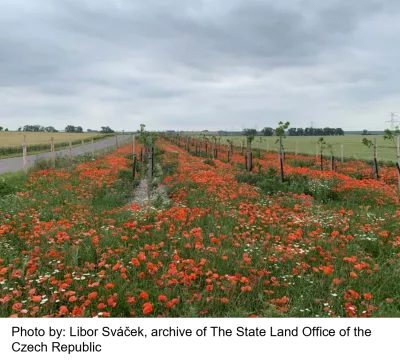General information
RDP Priority
- P2. Competitiveness
RDP Focus Area
- 2A: Farm’s performance, restructuring & modernisation
RDP Measure
- M04: Investments in physical assets
Summary
In recent years, the village of Vrbovec in Czechia has experienced substantial wind erosion, which negatively affected soil fertility on local agricultural land. To reduce these negative effects, the project aimed to create a sizeable strip of land functioning as a windbreak and anti-erosion protection measure. The project activities included several preparatory stages for the plantation of trees, shrubs and grasses. The new windbreak helps to improve the functionality of the overall ecosystem, increase the ecological stability of the area and enhance the diversity of its landscape features.
Results
- A newly planted windbreak with a total length of 737 metres and a width of 15 metres. In total, 805 trees and 3 980 shrubs were planted.
- An expected contribution to the restoration of a well-functioning ecosystem and the creation of a new habitat for the expansion of local fauna and flora.

Promoter
The State Land Office (SLO) – office Znojmo
Funding
Total budget 47 971 (EUR)
EAFRD 23 746 (EUR)
National/Regional 24 225 (EUR)
Resources
Context
The village of Vrbovec is located in the Znojmo district in the South Moravian Region of Czechia. This region is popular for its winegrowing and tourism industries. In recent years intensive land use and climate change have led to a gradual degradation of the soil through water and wind erosion.
Wind erosion has not only had a negative impact on the physical and chemical characteristics of the soil (with an associated reduction in soil fertility and yields from damaged crops) but has also led to a significant increase in the amount of dust. This resulted in a negative impact on the health of the local population. The need to reverse these problematic conditions and to eliminate the negative effects of wind erosion became more and more evident.
Objectives
The main aim of the project was to actively improve the soil’s protection from wind to lessen the negative effects and impacts of wind erosion on the area. It was hoped that, by re-structuring and re-planting key areas of the local landscape, a reduction of the amount of dust could be achieved. At the same time, the re-built landscape features, in the form of a windbreak, would help improve the functionality of the overall ecosystem, increase the ecological stability of the area and enhance the diversity of the landscape features.
Activities
The project incorporated the following key activities:
- Implementing basic geodetic work. This involved arranging utilities, marking key points to inform the planting for the windbreak and conducting an archaeological survey.
- Applying an anti-erosion treatment across an area of 1.13 ha.
- Preparing and planning the trees, shrubs and grasses to be planted in the defined areas.
- Implementing and planting the windbreak.
- Building a temporary forest fence with gates for access surrounding the entire area to protect the plantations against deer predation.
- Providing annual management of the plantation as well as communicating progress through related publications.
Main results
The project results included:
- A newly planted windbreak with a total length of 737 metres and a width of 15 metres. In total, 805 trees and 3 980 shrubs were planted. The herbaceous layer of the windbreak is based on a grass cover with a predominance of mesotrophic species.
- An expected contribution to the restoration of a well-functioning ecosystem and the creation of a new habitat for the expansion of local fauna and flora.
- The project has led to a further windbreak plantation that followed in August 2021. The new stage involves the planting of a species-rich area of trees on arable land. Apart from protecting the soil from wind erosion, the windbreak will also support the ecological stability of the area and will lead to an aesthetic improvement of the landscape. The estimated completion date of this initiative is November 2024.
Key lessons and recommendations
The construction of windbreaks is only one of many approaches that can be used to defend against the negative effects of wind erosion. Depending on the specificities of a particular area, other measures and procedures could be used on their own or in combination with each other, such as:
- Organisational measures to achieve an optimal shape and size of land parcel, protective grassed areas, strip crop rotation, etc.
- Agro-technical measures including soil structure modifications, soil moisture increases, direct seeding into a cover crop or stubble, mulching, etc.
- Biotechnical and other technical measures.
